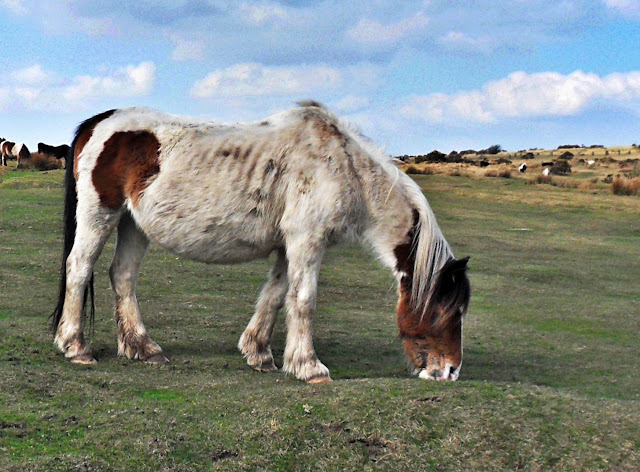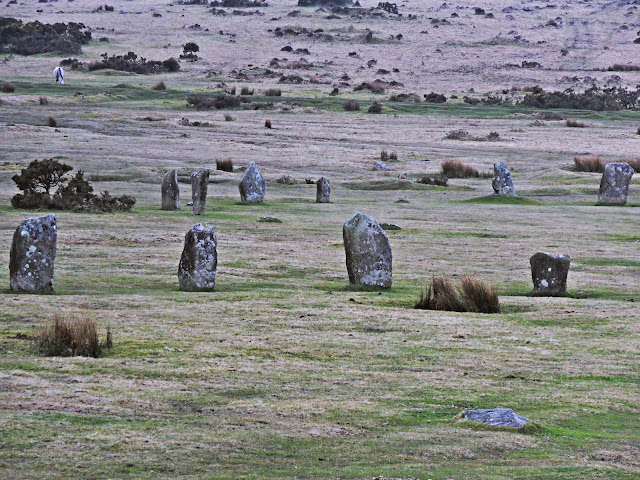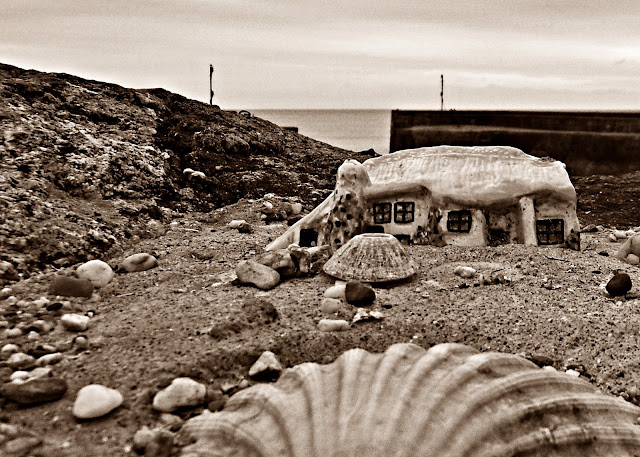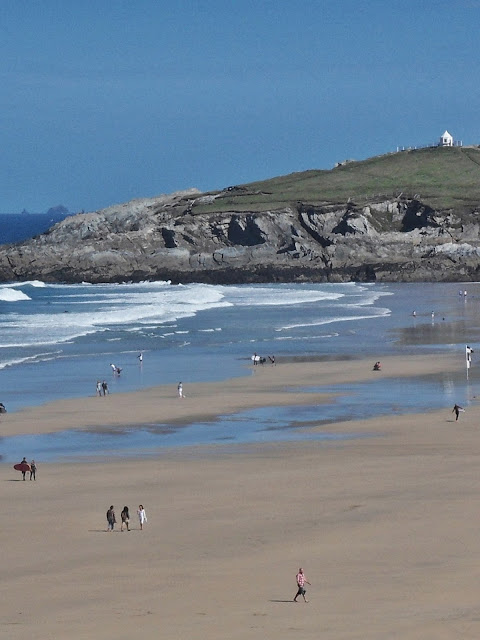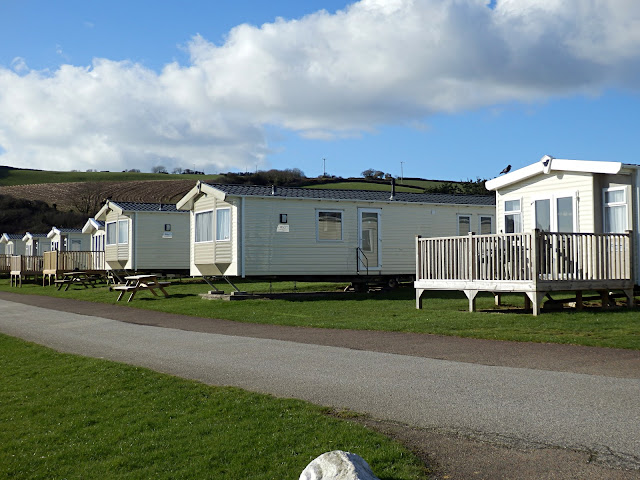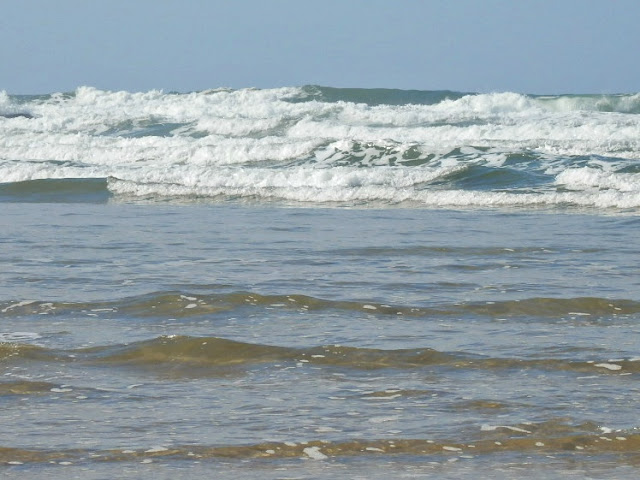Wednesday, 3 April 2019
Dando and His Dogs Hunting For Human Souls On Bodmin Moor
Following on from yesterday's post - we were walking on the mystical Bodmin Moor in Cornwall, England where there are wild ponies and other animals grazing the moorland.
It's good to see animals roaming free as they have done for thousands of years. The ponies happily posed for my photos.
As the wind blows across the wide expanse of moorland it's easy to imagine the legends of the moor coming to life. Dando and His Dogs could well be nearby hunting for human souls.
Fluffy, beautiful ponies are one thing, but Dando is something not to be messed with.
Hearing Dando's baying hounds echoing over the moor is enough to make even the bravest fear for their lives. If the dogs are heard it's best to move on quickly before the hunter catches sight of your soul. One poor fellow lingered until it was nearly too late, but fortunately he remembered what he had to do to escape. Others aren't so lucky or as well informed.
Dando the hunter is evil with big saucer like eyes, horns from his head and a tail blowing in the wind, he is the devil himself. With his hunting pole at the ready his dogs snort out fire, scorching the moorland surface as they snarl and snap at any unfortunate human.
The man I mentioned remembered the advice his father had given him as a child about Dando and his Dogs. The only way to escape is to surrender yourself to God and pray.
The man dropped to his knees and prayed and the dogs fell silent. Dando called for them to move on in pursuit of another soul - one who may not be aware of the secret knowledge to save him or her from evil.
It's not only Dando to be wary of while on the moor, oh no, there is also the Beast of Bodmin or perhaps beasts. These are big black cat like creatures the size perhaps of panthers or pumas. Many walkers on the moor claim to have seen them and sheep and cattle have been savaged by these beasts.
Also see:
The Mystery of theThree Hurlers Stone Circles on Bodmin Moor
Tuesday, 2 April 2019
The Mystery of the Three Hurlers Stone Circles On Bodmin Moor

Bodmin Moor, Cornwall can be can be an inhospitable place, especially when the weather is bad. It's not somewhere to get lost, that's for sure.
We visited the moor to see the Hurlers.
The Hurlers are three stone circles in a line and are said to be dated from around 1500-2100 BC, which makes them 3500 to 4000 years old. Some experts date them from the late Neolithic period and others to the early Bronze Age.
There are also two other monoliths, The Pipers, which are situated south-west of the center circle.
The Hurlers stone circles bring forth many questions such as : Why are there three of them - when one was enough for the likes of Stonehenge? What were they used for? Why would people want to create them? And so on, and so on.
The oldest answer comes from the late 1500s when a historian, William Camden. wrote in olde English:
"The neighbouring inhabitants terme them Hurlers, as being by devout and godly error perswaded that they had been men sometime transformed into stones, for profaning the Lord's Day with hurling the ball."
There were always simplistic religious answers back in the 1500s and 1600s: The Hurlers are men turned into stone because they dared to play the Cornish game of Hurlers on a Sunday! The two other stones were the Pipers who played music at the same time and were also turned into stone. I guess not many people will accept this as being true nowadays!
Oh, and there is one other legend about how it is impossible to count the number of stones in the circles.
Today we have other ideas as to what the Hurlers were all about but the truth is that no one really knows. They may have been used for some form of ceremony or perhaps they defined a meeting or trading place for local inhabitants.
There is also a new(ish) theory that the stones are aligned to the constellation of Orion.
One theory put forward by Brian Sheen, a retired research chemist and astronomer of the Roseland Observatory, links the Hurlers to the constellation of Orion and that they are a primitive calendar.
Mr Sheen explains: "As far as I can tell these Hurlers, a series of three stone circles, actually mirror the belt of Orion. Just once a year at the winter solstice Orion passes due south at midnight.
What happened is that this allowed the ancient people to tell the half way point between the autumnal equinox and the vernal equinox. This was important because the people were starting to grow things and look after animals. They were becoming farmers instead of hunter-gatherers.
It confirms that the people who built the Hurlers around 1500 BC were fully aware of day length and season and had more knowledge of astronomy than we thought."
While on the moor, we walked further than the stone circles, but the weather began to change. It's easy to see how anyone could become disorientated on the moor.
Monday, 1 April 2019
Stepping Back In Time At Charlestown
I often seem to be saying that visiting the harbour at Charlestown, Cornwall 'is like stepping back in time'. So I thought I would do a few photos in sepia to see if the harbour does indeed look very 'olde worlde'.
The old tall sailing ships in dock at Charlestown certainly give the look of days gone by, as do the old narrow stone steps down to the bottom of the harbour - useful as the harbour is tidal so the water level varies.
And, I guess, if Charlestown is like like stepping back in time, it has to include any secret piskey (Cornish pixies) homes as well.
Other Charlestown Posts:
Charlestown Harbour On A Sunshine Morning
Walking The Beach at Charlestown. Cornwall
The Cave on Charlestown Beach, Cornwall
Sunday, 31 March 2019
Fistral Beach - One of Newquay's Finest For Surfing
Fistral Beach, Newquay, Cornwall is one of the best for surfing, because of the consistency and quality of the surf. Newquay is considered to be the surfing capital of the UK.
It's a lovely stretch of sand and high on the cliffs is the impressive Headland Hotel.
The hotel was first opened in June 1900 and has hosted royalty. King Edward VII and Queen Alexandra were the first to stay at the hotel in the early 1900s. The current Prince of Wales (Prince Charles) and the Princess Royal (Princess Ann) have also enjoyed several visits - at least I presume they enjoyed themselves! Hard to tell what they are thinking at times.
The town of Newquay is on Cornwall's north coast and is very much a seaside resort. The population of the town is about 20,000 but this shoots up to nearer 100,000 in the main summer season. So to say it gets busy is an understatement - it heaves people in the main summer holiday period. The attraction? Sandy beaches, I think there are 11! Oh, and surfing, as I have already mentioned.
In the photo above, on the cliff top is a small white building. This is the Huers Hut mentioned in a previous post.
Changing the subject, there was a recent clean up of Fistral Beach and they found litter going back to the 1970s and 80s! The rubbish lay buried under a collapsed sand dune.
I have a bit of a bee in my bonnet about litter, I detest it and don't understand why people can't take their rubbish home. Why pollute beautiful scenery? But the other thing about some of the items found is that they have survived for perhaps 30+ years. We really are polluting our Earth - and not just with plastic.
Grumble over! Here are just some of the items found under the sand dune ...
~ 1984 Smiths Crisps packet that offers a free Indiana Jones and the Temple of Doom Poster
~ Coca Cola can dated 1984
~ A Marathon chocolate bar dated 1984
~ Packet from Golden Wonder crisps offering a model of a Laker Airways DC-10 - Laker went bankrupt in 1982
~ Burton's Smax
~ Treets, who changed their name in 1988
... and so it went on.
Saturday, 30 March 2019
A March Day On Pentewan Beach In Mevagissey Bay, Cornwall
A sunny March day on Pentewan Beach in Mevagissey Bay, Cornwall. Some are even brave enough to take to the water.
Just behind the beach is a caravan and camping park, Pentewan Sands, with five star ratings. Looks quiet in the photo but is very popular in the summer months with holiday makers. I guess the main attraction is the nearness of the beach. But there is also entertainment for kids and adults, a swimming pool, restaurant, fish & chips and so on.
I must admit, though, I prefer the beach in the winter and early Spring when there are less people about.
Other Pentewan Posts:
A Short Walk Along The Pentewan Trail
Pentewan: Comparing How It Looked In 1900 With Today
Friday, 29 March 2019
The Giant Gunnera Thrives In Cornwall
Cornwall has a mild climate and is not too extreme in the winter. This means we have all sorts of different plants growing, including palm trees - and the likes of the Gunnera as in my photos.
The photos were snapped in my son's garden before he moved - but he somehow managed to take the gunnera with him to his new house. As you can see the plant was as high as his garage - and grows even taller.
According to Wikipedia the plant is native to Latin America, Australia, New Zealand, Papuasia, Hawaii, Africa and Madagascar.
There are many good examples of the Gunnera in Cornwall, especially at the Lost Gardens of Heligan, The leaves die off in the winter but return in Spring.
Thursday, 28 March 2019
The Pleasures of Mawgan Porth Beach, Cornwall
This is Mawgan Porth beach. A while back the Times Newspaper included the beach in it's Top 10 Holiday Beaches. They wrote: There are better known and busier beaches in Cornwall, but few can match the raw beauty of Mawgan Porth, on the north coast near Newquay. Shielded on both sides by cliffs, it has acres of soft white sand, rock pools, caves and magical sunsets.
The first five of today's photos, of Mawgan Porth, were snapped as the tide was going out on a lovely sunny early morning - so not very many people on the beach - perfect!
The tide does go out a long way, as can be seen by the photo above, but it leaves behind soft squelchy sand with a few clear water pools - oh, and beautiful clean air - breathe deeply - ahhhh!
When the tide is out it's possible to explore caves in the cliffs, which are normally hidden by the sea.
The following three photos were again snapped in the morning, but the sky wasn't so blue and the sea perhaps not so inviting. This is the Atlantic coast so the waves are suitable for surfing.
A small river joins the beach ...
... while the waves start to build.
Mawgan Porth is situated between Newquay and Padstow on Cornwall's north coast.
Subscribe to:
Posts (Atom)
FEATURED POST
Cornwall's Lizard Peninsula
I know my wife and I and live in Cornwall but we had a break away from home on Cornwall's L izard Peninsula - one of our favourit...






